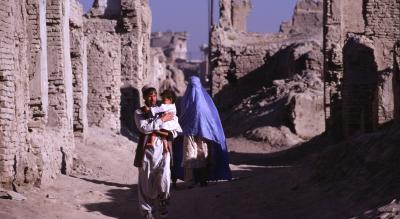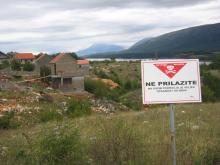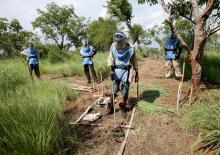Case prepared by Ran Yosef, LL.B student at IDC University, under the supervision of Adv. Yael Vias Gvirsman, Clinic Director, IDC University; with the contribution of Jemma Arman and Isabelle Gallino, LL.M. students at the Geneva Academy.
A. NATO’S ISAF TACTICAL DIRECTIVE ON THE EMPLOYMENT OF FORCE
Our strategic goal is to defeat the insurgency threatening the stability of Afghanistan. Like any insurgency, there is a struggle for the support and will of the population. Gaining and maintaining that support must be our overriding operational imperative - and the ultimate objective of every action we take.
We must fight the insurgents, and will use the tools at our disposal to both defeat the enemy and protect our forces. But we will not win based on the number of Taliban we kill, but instead on our ability to separate insurgents from the center of gravity - the people. That means we must respect and protect the population from coercion and violence - and operate in a manner which will win their support.
This is different from conventional combat, and how we operate will determine the outcome more than traditional measures, like capture of terrain or attrition of enemy forces. We must avoid the trap of winning tactical victories - but suffering strategic defeats - by causing civilian casualties or excessive damage and thus alienating the people.
While this is also a legal and a moral issue, it is an overarching operational issue - clear-eyed recognition that loss of popular support will be decisive to either side in this struggle. The Taliban cannot militarily defeat us - but we can defeat ourselves.
I recognize that the carefully controlled and disciplined employment of force entails risks to our troops - and we must work to mitigate that risk wherever possible. But excessive use of force resulting in an alienated population will produce far greater risks. We must understand this reality at every level in our force.
I expect leaders at all levels to scrutinize and limit the use of force like close air support (CAS) against residential compounds and other locations likely to produce civilian casualties in accordance with this guidance. Commanders must weigh the gain of using CAS against the cost of civilian casualties, which in the long run make mission success more difficult and turn the Afghan people against us.
I cannot prescribe the appropriate use of force for every condition that a complex battlefield will produce, so I expect our force to internalize and operate in accordance with my intent. Following this intent requires a cultural shift within our forces - and complete understanding at every level - down to the most junior soldiers. I expect leaders to ensure this is clearly communicated and continually reinforced.
The use of air-to-ground munitions and indirect fires against residential compounds is only authorized under very limited and prescribed conditions (specific conditions deleted due to operational security).
(NOTE) This directive does not prevent commanders from protecting the lives of their men and women as a matter of self-defense where it is determined no other options (specific options deleted due to operational security) are available to effectively counter the threat.
We will not isolate the population from us through our daily conduct or execution of combat operations. Therefore:
Any entry into an Afghan house should always be accomplished by Afghan National Security Forces (ANSF), with the support of local authorities, and account for the unique cultural sensitivities toward local women.
No ISAF forces will enter or fire upon, or fire into a mosque or any religious or historical site except in self-defense. All searches and entries for any other reason will be conducted by ANSF.
The challenges in Afghanistan are complex and interrelated, and counterinsurgencies are difficult to win. Nevertheless, we will win this war. I have every confidence in the dedication and competence of the members of our force to operate effectively within this challenging environment. Working together with our Afghan partners, we can overcome the enemy's influence and give the Afghan people what they deserve: a country at peace for the first time in three decades, foundations of good governance, and economic development.
B. OPERATIONALIZING THE LESSONS LEARNT ON THE PROTECTION OF CIVILIANS
[…]
Some argue that any efforts to protect civilians beyond what is required in the law of armed conflict, or LOAC, constitute unnecessary restrictions on the use of force and could endanger our soldiers on the ground. Others argue that the United States military should go above and beyond the minimum rules of engagement to protect civilians. Both views have some merit; however, neither captures reality in all cases.
Today’s wars that are typically fought among the people often result in a third critical task – protection of the civilian populace. In the wars of the post-9/11 era, balancing the need to protect our force while minimizing civilian casualties has become increasingly difficult – and increasingly consequential to successful accomplishment of the mission. The enemies we and our partners have fought frequently have located in population centers – a phenomenon that has grown more commonplace with the increase in urbanization around the world. The guerrillas and insurgents (and even the Islamic State’s army) we have fought have often used civilians as shields, thus complicating the job of soldiers on the ground carrying out operations to capture or kill or clear the enemy from the populations we are seeking to secure.
It is frequently critical that we and our host nation partners gain the support of the people. Their active support is needed for host nations to win; by contrast, their passive or active support of our adversaries enables insurgencies to endure. Legitimacy in the eyes of the population is essential for success.
As we found in Afghanistan, an approach that places insufficient emphasis on civilian protection can undermine achievement of our strategic objectives and increase the risk to our forces. In a new report by Open Society Foundations, one of us, co-author Christopher Kolenda, argues that civilian harm in Afghanistan by members of the International Security Assistance Force, or ISAF, and Afghan forces – particularly in the early-to-mid-2000s – played a significant role in the growth and sustainability of the Taliban and undermined the legitimacy of coalition and Afghan government. These problems, at a minimum, intensified the conflict and made joint objectives more difficult to achieve.
International military operations reportedly killed 828 Afghan civilians in 2008 – 39 percent of the total civilian fatalities that year. This prompted the Taliban to use civilian casualties as major propaganda and recruiting tools, reinforcing the perception that international forces were careless about Afghan lives. By 2009, Afghans were reportedly losing faith in their government and in the international mission.
We began to take serious action to address the issue in 2009. Gen. Stanley McChrystal, the new ISAF commander, went to great lengths to explain why civilian protection had to become central to the campaign. His directives required commanders to think more carefully about the consequences of civilian casualties on force protection and mission accomplishment.
As the first year of the directives was completed, however, there was substantial concern on the ground that force protection was being unduly limited by the efforts to avoid civilian casualties. The other of us (David Petraeus) was asked to address this issue during my confirmation hearing to command ISAF in June 2010. After taking command in early July, I reviewed the directives in force and concluded that, while they were generally sound, some commanders below COMISAF had been placing additional restrictions on the use of force, thereby increasing the risk of lost opportunities to engage the enemy and hampering the ability to do all necessary to protect our soldiers in difficult situations.
After consulting our commanders and completing my review, I removed the freedom to add to the restrictions established at my level, and sought to reinforce both the importance of civilian protection to accomplishment of our mission and the right to employ all necessary measures in defending our troopers in difficult situations. The subsequent implementation of this intent went well, and we simultaneously helped refine pre-deployment training conducted for leaders and units in the U.S. And we also upgraded our collection and analysis of data that helped our commanders understand the extent to which civilian casualties affected achievement of both our strategic objectives and force protection.
Gens. John Allen and Joe Dunford, my successors as commander of coalition and U.S. forces in Afghanistan, further refined our procedures and processes as the campaign progressed. The results were significant. From 2010 to 2012, the period of our surge in forces in Afghanistan, not only were there significant security gains in former Taliban strongholds such as Helmand and Kandahar, but ISAF-caused civilian casualties were reduced by 41 percent. And U.S. military losses during ground engagements declined by 22 percent.
[…]
C. AFGHAN WAR’S CIVILIAN DEATHS FELL IN 2012, U.N. SAYS
KABUL — Civilian deaths caused by the war in Afghanistan have dropped for the first time in six years, the United Nations said Tuesday in its annual report on the conflict’s toll on noncombatants.
The report linked the 12 percent drop in civilian deaths in 2012 to reduced ground fighting by the warring sides, chiefly the Taliban and U.S. troops; a decrease in the number of NATO coalition airstrikes; and fewer suicide attacks by insurgents.
[…]
For years, civilian deaths caused by foreign troops have been a thorny issue between President Hamid Karzai and his Western backers, especially the United States, even though, according to the U.N. report, militants are responsible for far more such casualties — 81 percent in 2012 — than NATO forces. Eight percent of civilian casualties were attributed to coalition forces, the report said; 11 percent were not linked to a specific cause.
Civilian casualties resulting from air operations by Western forces dropped by 42 percent in 2012 compared with 2011, the report said, data that support NATO’s oft-stated position that its airstrikes against militants have become more precise.
But the report stressed “the still critical need for continuous review of targeting criteria” to further reduce civilian deaths from aerial attacks. “Of the 126 civilian deaths from aerial operations, 51 were children,” the report noted.
[...]
After 10 civilians died last week in a NATO airstrike that was requested by Afghan security forces in eastern Konar province, Karzai issued a decree that bars the national forces from seeking such air support in residential areas.
On Sunday, Gen. Joseph F. Dunford Jr., the top U.S. and NATO commander in Afghanistan, expressed support for Karzai’s order and said the international coalition can operate effectively despite the ban.
Discussion
I. Classification of the Situation and Applicable Law
1. How would you qualify the situation in Afghanistan after 2002? What additional information would you need to make such a determination? (
GC I-IV, Art. 3;
P II, Art. 1)
2. Is NATO a party to the conflict? Are the troop contributing member countries of NATO parties to the conflict? Does NATO’s involvement in Afghanistan influence the classification of the conflict? Which rules of IHL apply to NATO forces in Afghanistan?
II. Conduct of Hostilities
4. (Document B) What does IHL say on using civilians as shields? And on military objectives located in population centers? (
P I, Art. 51;
P I, Art. 58)
5. Can the death of civilians ever be lawful in IHL? Does IHL oblige a party to avoid civilian casualties at all costs? What guidance, if any, does IHL provide on weighing military objectives against anticipated civilian casualties? (
P I, Art. 51)
6. This article mentions “balancing the need to protect our force while minimizing civilian casualties”. Is the protection of a State’s own forces a relevant consideration in assessing proportionality or the precautions required in attack? (
P I, Art. 51,
P I, Art. 57)
III. Elements Contributing to Respect for IHL
7. (Document A) What is the basic idea of the ISAF Tactical Directive? What reasons are identified for respecting and protecting the civilian population? Why was this considered critical, at an operational level, for fighting an insurgency movement? Do you think this is more important when the armed group fighting the insurgency movement is a foreign coalition? How might a non-state armed group use the fact of civilian casualties to support their cause?
8. Why do you think soldiers were directed to be accompanied by a member of ANSF when entering houses? Why would it be valuable for soldiers to respect local cultural sensitivities? How do you think the community would respond to the firing on religious or historical sites?
9. Who are the direct recipients of this Directive? Who has to apply the strategic measures recommended in the Directive? What do you think the “cultural shift” referred to? Do you think that the soldiers were being asked to adjust their responses to risky situations? To have a longer-term perspective on risk?
10. (Document B) For what reasons was the Tactical Directive issued? What were the results of the Tactical Directive according to this article? In particular, what were the results for the parties to the conflict who had to implement it? What about other parties? Why do you think ISAF also saw a reduction in civilian casualties?
11. (Document C) What factors may have influenced President Karzai to order a ban on airstrikes in residential areas? Do you think perceptions of non-compliance with IHL can weaken a politician’s domestic political support? Was NATO obliged to follow the order of President Karzai?






